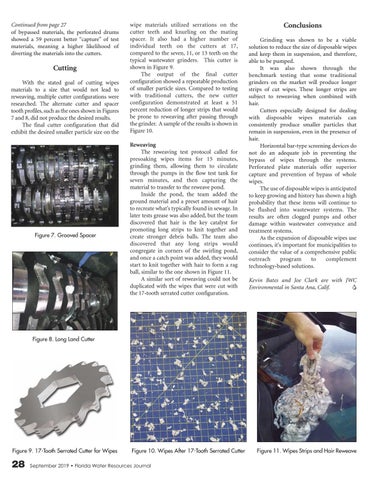Continued from page 27 of bypassed materials, the perforated drums showed a 59 percent better “capture” of test materials, meaning a higher likelihood of diverting the materials into the cutters.
Cutting With the stated goal of cutting wipes materials to a size that would not lead to reweaving, multiple cutter configurations were researched. The alternate cutter and spacer tooth profiles, such as the ones shown in Figures 7 and 8, did not produce the desired results. The final cutter configuration that did exhibit the desired smaller particle size on the
Figure 7. Grooved Spacer
wipe materials utilized serrations on the cutter teeth and knurling on the mating spacer. It also had a higher number of individual teeth on the cutters at 17, compared to the seven, 11, or 13 teeth on the typical wastewater grinders. This cutter is shown in Figure 9. The output of the final cutter configuration showed a repeatable production of smaller particle sizes. Compared to testing with traditional cutters, the new cutter configuration demonstrated at least a 51 percent reduction of longer strips that would be prone to reweaving after passing through the grinder. A sample of the results is shown in Figure 10. Reweaving The reweaving test protocol called for presoaking wipes items for 15 minutes, grinding them, allowing them to circulate through the pumps in the flow test tank for seven minutes, and then capturing the material to transfer to the reweave pond. Inside the pond, the team added the ground material and a preset amount of hair to recreate what’s typically found in sewage. In later tests grease was also added, but the team discovered that hair is the key catalyst for promoting long strips to knit together and create stronger debris balls. The team also discovered that any long strips would congregate in corners of the swirling pond, and once a catch point was added, they would start to knit together with hair to form a rag ball, similar to the one shown in Figure 11. A similar sort of reweaving could not be duplicated with the wipes that were cut with the 17-tooth serrated cutter configuration.
Conclusions Grinding was shown to be a viable solution to reduce the size of disposable wipes and keep them in suspension, and therefore, able to be pumped. It was also shown through the benchmark testing that some traditional grinders on the market will produce longer strips of cut wipes. These longer strips are subject to reweaving when combined with hair. Cutters especially designed for dealing with disposable wipes materials can consistently produce smaller particles that remain in suspension, even in the presence of hair. Horizontal bar-type screening devices do not do an adequate job in preventing the bypass of wipes through the systems. Perforated plate materials offer superior capture and prevention of bypass of whole wipes. The use of disposable wipes is anticipated to keep growing and history has shown a high probability that these items will continue to be flushed into wastewater systems. The results are often clogged pumps and other damage within wastewater conveyance and treatment systems. As the expansion of disposable wipes use continues, it’s important for municipalities to consider the value of a comprehensive public outreach program to complement technology-based solutions. Kevin Bates and Joe Clark are with JWC Environmental in Santa Ana, Calif. S
Figure 8. Long Land Cutter
Figure 9. 17-Tooth Serrated Cutter for Wipes
28
Figure 10. Wipes After 17-Tooth Serrated Cutter
September 2019 • Florida Water Resources Journal
Figure 11. Wipes Strips and Hair Reweave
